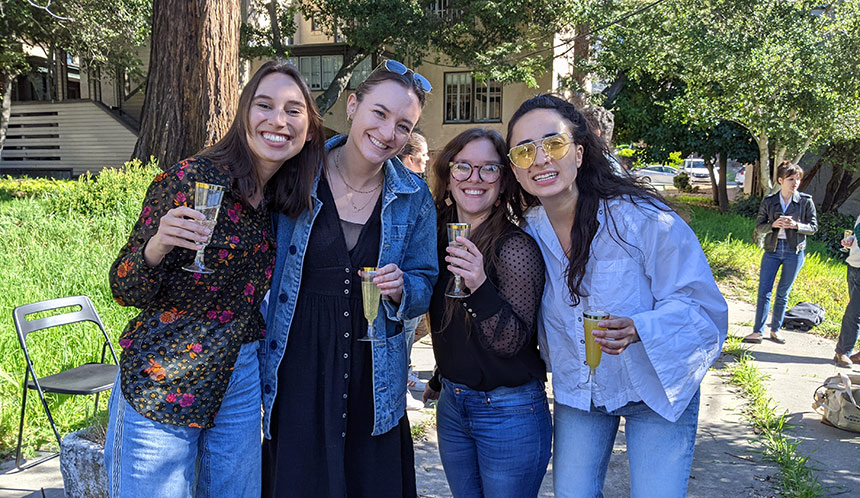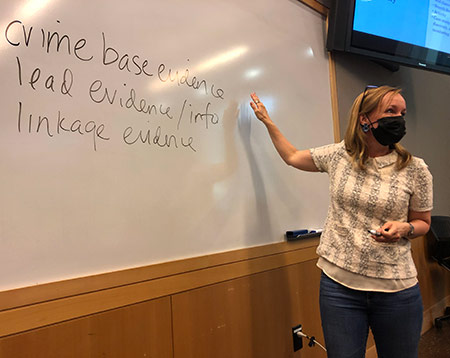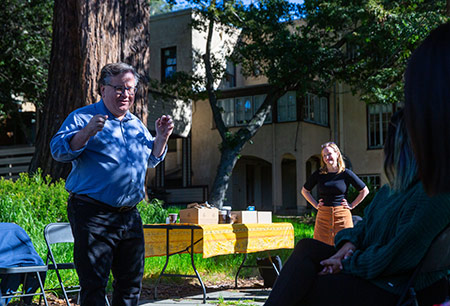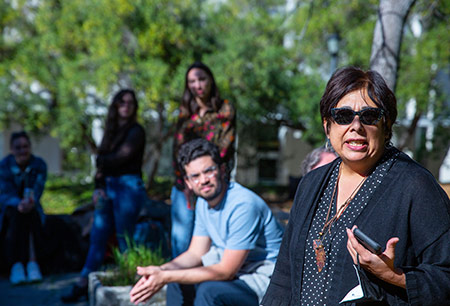
By Gwyneth K. Shaw
Berkeley Law’s Human Rights Center has exposed war crimes, atrocities, and other international law violations around the globe for nearly 30 years. A new project that’s just been released instead scrutinizes a domestic issue: the legal, scientific, and medical campaign to curtail reproductive rights, as part of a collaboration with the Investigative Reporting Program at the UC Berkeley Graduate School of Journalism.
“A Strike at the Heart of Roe” debuted Feb. 12 on the weekly radio show from Reveal, a nonprofit news organization that’s part of the Center for Investigative Reporting. It tracks the growing success of so-called “heartbeat bills,” which seek to outlaw abortion after fetal cardiac activity can be detected, typically around six weeks of gestation.
Texas’ version, S.B. 8, took effect last year, and other states are passing similar laws that reproductive rights advocates say gut the right to abortion enshrined in the U.S. Supreme Court’s 1973 Roe v. Wade decision.

At what seems to be a critical juncture for reproductive rights in the U.S. — the court is expected to rule later this spring on Mississippi’s abortion ban after 15 weeks’ gestation — the show, which reaches over 1 million listeners on more than 580 National Public Radio stations each week, is timely.
“This story offered an invaluable opportunity to partner with some of the best investigative reporters in the business to explore how science and law have been strategically used to attack Roe v. Wade, and ultimately weaponized against women’s reproductive rights,” HRC Executive Director Alexa Koenig ’13 says.
Work on the project began in the fall Human Rights and War Crimes Investigations course she taught with HRC Faculty Director Eric Stover, as well as a new open source (OSINT) journalism class that the HRC launched with faculty from the Journalism School’s Investigative Reporting Program. The semester began just as S.B. 8 took effect in Texas.
Both groups of students worked with Reveal reporters and editors to track where the ideas underpinning these bills came from — and how they went from fringe proposals to a slam-dunk policy in Republican-controlled state houses, while facing little resistance in state and federal courts. The spring OSINT course has law and journalism students continuing the collaboration.
Reveal’s Features Editor Nina Martin says the goal of the piece was to understand not just the origin story of the Texas heartbeat bill, but how Texas had become the heart of the anti-abortion movement.
Many journalists had stopped writing about the Texas law and focusing on the Mississippi case, “but it was clear to us that S.B. 8 had already pretty much gutted Roe,” Martin says.
The audio format made sense, she adds, because some of the story wouldn’t translate to the page. In particular, the episode goes into extensive detail about what, exactly, you hear when listening for a heartbeat in a six-week-old fetus.
“The backstory of S.B. 8 is a pretty brainy topic, and audio is a very emotional medium,” Martin says. “The radio/podcast format really helped us bring to life a story that otherwise could have seemed abstract and dry.”
Pioneering protocols
Founded in 2016, HRC’s Investigations Lab is pioneering new ways to mine social media and other online open source information for fact-finding efforts, including journalism, human rights research, and legal investigations. In 2020, the center published the Berkeley Protocol on Digital Open Source Investigations, in partnership with the United Nations Human Rights Office, which sets global standards for using online open source research methods.
“This partnership — through the journalism class, the law class, and the reporting process — allowed us to explore new ways of bringing these open source investigation methods into investigative reporting,” Koenig says.

It also strengthened the ties between the Investigative Reporting Program (IRP) at the School of Journalism and the HRC at Berkeley Law, bringing together a team of visionaries and veterans from both organizations — as well as Reveal and the Associated Press, which will publish its own project shortly. Open source investigations are strongest when they’re collaborative, Koenig says, and “the team that came together to work on this was truly exceptional.”
The group included journalism professor David Barstow, winner of four Pulitzer Prizes at The New York Times and leader of the IRP; award-winning reporter Gisela Perez de Acha, who splits her time between the HRC and the IRP and served as supervising reporter for the Berkeley team; and journalism professor Richard Koci Hernandez. HRC graduate student researcher Brian Nguyen, Investigations Lab co-founder Andrea Lampros, and lab director Stephanie Croft rounded out the HRC team, along with Koenig.
Key members of the Reveal team included reporting fellow Grace Oldham, freelance reporter Amy Littlefield, radio producers Katharine Mieszkowski and Nadia Hamdan, and radio editors Cynthia Rodriguez and Casey Miner.
Berkeley Law Professor Emerita Kristin Luker, who co-founded the school’s Center on Reproductive Rights and Justice, supported the project with a comprehensive memo on the jurisprudence of abortion.
It all made for a prime experiential learning opportunity for the law students, Koenig says.
“Instead of conducting legal research for a class paper that may never contribute to anything besides a grade or personal understanding of an issue, this was a chance to conduct legal research for a real-world partner and potentially have significant impact with that research,” she says. “Second, lawyers need to know how to translate complex legal concepts into something that can be readily understood by people without law degrees, including clients and juries; as part of this process, the law students’ job was to do the legal research and be able to explain their findings to journalists in a way that those journalists could then explain to a general public.
“Finally, they had a chance to learn how relatively new forms of fact-finding, including on social media sites and other non-traditional online places, can complement more traditional research and evidence collection methodologies, placing them at the cutting edge of international legal practice.”
Critical help
The law students have been crucial to the project in many ways, Martin says, from helping the team understand jurisprudence nuances on the right to privacy and the rise of the religious freedom argument to the connections between the Texas law and early legislation creating “sanctuary cities” for the unborn.
Martin recalls how Emma MacPhee ’23 came in one afternoon last fall looking overwhelmed: Her assignment that week had been to put together a chronology of abortion-related Texas cases over the years, but she had barely made a dent because there were so many. It was a lightbulb moment for the team.

“So much of the backstory of S.B. 8 is about the development and manipulation of law and courts,” Martin says. “We couldn’t have told that story without the law students.”
MacPhee created a timeline of the legislative and judicial history of abortion restrictions in Texas and profiled Jonathan Mitchell, the architect of the novel legal theory behind S.B. 8, which effectively creates a system where citizens can collect as much as $10,000 for accusing someone of having an abortion, or helping someone get one.
She says she enjoyed getting a peek behind the scenes at the effort that goes into a story like the Reveal show, and also exploring the intersection of law and journalism.
“I’m hoping to continue to advocate for the expansion of reproductive rights and services in my future legal career,” MacPhee says. “I’ve loved working with Professor Koenig and the Reveal team on this project and applying the skills we’re learning in class to my legal research on reproductive justice and abortion issues.”
Leah Roemer ’23 just joined the team at the beginning of this semester, as part of the OSINT course. In the run-up to the Reveal show’s release, she dug into Mitchell’s influence and power as a legal architect on the right, particularly his successful history before the U.S. Court of Appeal for the Fifth Circuit — which has played a big role in S.B. 8 taking effect in Texas.
Roemer says the project has been one of her favorite experiences in law school, that it was exciting to be part of a newsroom-style deadline effort, and how she’s inspired by the interdisciplinary careers of Koenig and Perez.
“This has helped drive home just how many ways you can put a law degree to good use,” Roemer says. “I’m now exploring legal journalism and creative writing as tools to move the needle on issues I care about.”
Taylor Graham ’23, who was a journalist and documentary filmmaker before law school, says working with Reveal journalists reminded him that good lawyering often means telling a good story.
“My experience working with Reveal enabled me to apply the legal learning I’ve done at Berkeley Law in an interdisciplinary way that allowed me to see issues in a whole new light,” he says. “The discussions we had as a team always challenged me to go beyond thinking about how a particular issue might play out in court to thinking about what the real-world impact of a particular outcome might be.”
Martin, too, says she learned a lot from the HRC’s investigative tool set, and thoroughly enjoyed the collaboration.
“I have loved coming to the Berkeley campus every week and reveling in the opportunity to be with very smart and committed people — in person!— talking about very important ideas,” she says. “Working on this project, especially interacting with the students and staff, has been a bright spot in a very bleak news year.”
Koenig, who had been looking for a project focused on gender and reproductive rights, says this team effort is a perfect reflection of HRC’s motto: pursuing justice through science and law.
“Ultimately, whether you’re a lawyer or a journalist, facts are your currency,” she says. “Our jobs require that we know how to obtain — and how to hold or even increase the value of — that currency, by sourcing reliable information that can be used to strengthen the world’s understanding of current events, and ultimately strengthen the potential for justice.”